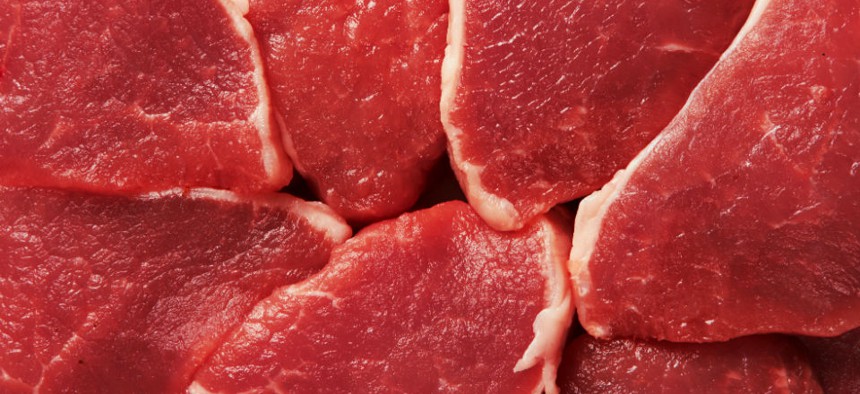
Volodymyr Krasyuk / Shutterstock.com
Should Red Meat Warnings Include Damage to the Environment?
A political battle shapes up around federal dietary guidelines.
There's a real food fight happening in Washington.
Green groups want the government to tell Americans that eating less meat benefits the earth. And environmentalists are lobbying to add what amounts to a climate-change warning to federal dietary guidelines.
But while a multiagency advisory panel has given activists reason for optimism, Congress has cast doubt on the idea, and food industry lobbyists are pressing their case on and off Capitol Hill.
The food fight has so far revolved around the federal dietary guidelines—a metric that millions of Americans consult when deciding what to eat, and the blueprint that determines the makeup of school lunches and a wide array of government meal programs.
And the stakes are high. Americans are eating less red meat than they have in decades, and farmers and ranchers could feel the pinch if federal guidelines cast meat in a less-than-favorable light. Environmentalists, meanwhile, see the battle as a way to cut carbon emissions at a time when major legislation to address climate change is dead-on-arrival on the Hill.
Final recommendations for the guidelines are expected to arrive any day now, and the Agriculture and Health and Human Services departments must finalize the nutritional roadmap within the year. Environmentalists want those guidelines to warn Americans that red meat packs a far greater carbon-footprint punch than fruits and vegetables.
Beef and cattle make up the single largest segment of U.S. agricultural production. And all those animals have left a mark. The industry adds roughly 14.5 percent to worldwide greenhouse-gas emissions, according to the Food and Agriculture Organization of the United Nations.
So far, activists see reason for optimism. An advisory panel tasked with making recommendations for the guidelines has singled out sustainability as a key area of interest. The panel went a step further this fall, saying that a diet higher in "vegetables, fruits, whole grains, legumes, nuts and seeds" and lower in "animal based foods" is not only healthier but also better for the environment.
Environmentalists applauded. "You can't talk about public health without impacting the environment. The two are intertwined," said Kari Hamerschlag, a sustainable food and agriculture advocate with Friends of the Earth.
But lobbyists for the meat industry say that sustainability is far beyond the scope of the advisory panel.
"This needs to be about nutrition. The purpose here is to give Americans the information they need to make healthy choices. This is not the time or the place to get into sustainability," said Janet Riley, the senior vice president for public affairs at the North American Meat Institute.
A growing chorus of industry voices have criticized the pronouncement of the advisory panel. And the National Cattlemen's Beef Association, the National Pork Producers Council, and the National Chicken Council are all registered to lobby on the guidelines.
Industry won one round when Congress passed a massive spending bill in December that ordered the administration to disregard "environmental factors" when issuing the guidelines.
The nonbinding directive denounced the effort to incorporate "sustainability, climate change and other environmental factors" into the recommendations. But USDA and HHS remain free to craft the guidelines any which way they want—and the fight is far from over.
To further ward off environmental attacks, the industry has also taken pains to prove that meat is a sustainable source of food.
One argument the industry has made is to say that processed foods are a prime example of sustainability.
"Processed meats like bacon and lunch meats are sustainable because they take cuts of meat that might otherwise not be used, and that cuts down on waste," Riley said, adding: "Sausage was the original sustainable food."
Regardless, green groups say that even if the nutritional roadmap does not weigh in on red meat's environmental impact, they believe that the door is now open for future change.
"More people are starting to think about what they eat and where that food comes from and how that impacts the environment, and that's a conversation that the U.S. really needs to have," Hamerschlag said.
Stephanie Stamm contributed to this article.
(Image via Volodymyr Krasyuk / Shutterstock.com)







